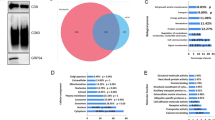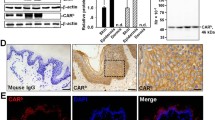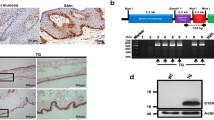Abstract
HMGb1 is a DNA-binding protein whose role as an extracellular cytokine in inflammation and tissue regeneration has also been reported. Given the importance of keratinocytes in wound healing, we have studied the mechanism of action of HMGb1 on HaCaT keratinocytes during in vitro scratch wound repair. Western blot and confocal immunofluorescence microscopy showed that these cells express significant amounts of HMGb1, that the protein is prevalently localized in the nucleus, and that its release by cells is negligible. Western blot also showed that these cells express the HMGb1 receptor RAGE. Cell exposure to HMGb1 in the absence of serum resulted in a stimulation of cell proliferation and ERK1/2 activation. HMGb1 also accelerated the wound closure of scratch wounded cells and promoted cell migration, as evaluated by a transwell assay. The HMGb1-induced increases of cell proliferation, cell migration, and wound closure were abolished by the MEK inhibitor PD98059. Taken together, data show that, although HMGb1 is not released by HaCaT, when applied exogenously it can induce a marked increase of the wound repair of these cells. Data also suggest that HMGb1 acts via the RAGE/MEK/ERK pathway. These results bring scientific support to the potential application of HMGb1 in regenerative medicine.







Similar content being viewed by others
References
Pisetsky DS, Erlandsson-Harris H, Andersson U (2008) High-mobility group box protein 1 (HMGB1): an alarmin mediating the pathogenesis of rheumatic disease. Arthritis Res Ther 10:209
Ulloa L, Messmer D (2006) High-mobility group box 1 (HMGB1) protein: friend, foe. Cytokine Growth Factor Rev 17:189–201
Ellerman JE, Brown CK, de Vera M, Zeh HJ, Billiar T, Rubartelli A et al (2007) Masquerader: high mobility group box-1 and cancer. Clin Cancer Res 2007(13):2836–2848
Palumbo R, Sampaolesi M, De Marchis F, Tonlorenzi R, Colombetti S, Mondino A et al (2004) Extracellular HMGB1, a signal of tissue damage, induces mesoangioblast migration and proliferation. J Cell Biol 164:441–449
Chavakis E, Hain A, Vinci M, Carmona G, Bianchi ME, Vajkoczy P et al (2007) High-mobility group box 1 activates integrin-dependent homing of endothelial progenitor cells. Circ Res 100:204–212
Limana F, Germani A, Zacheo A, Kajstura J, Di Carlo CA, Borsellino G et al (2005) Exogenous high-mobility group box 1 protein induces myocardial regeneration after infarction via enhanced cardiac C-kit + cell proliferation and differentiation. Circ Res 97:73–83
De Mori R, Straino S, Di Carlo A, Mangoni A, Pompilio G, Palumbo R et al (2007) Multiple effects of high mobility group box protein 1 in skeletal muscle regeneration. Arterioscler Thromb Vasc Biol 27:2377–2383
Efron PA, Moldawer LL (2004) Cytokines and wound healing: the role of cytokine and anticytokine therapy in the repair response. J Burn Care Rehabil 25:149–160
Werner S, Grose R (2003) Regulation of wound healing by growth factors and cytokines. Physiol Rev 83:835–870
Boukamp P, Petrussevska RT, Breitkreutz D, Hornung J, Markham A, Fusenig NE (1988) Normal keratinization in a spontaneously immortalized aneuploid human keratinocyte cell line. J Cell Biol 1063:761–771
Matsuura K, Kuratani T, Gondo T, Kamimura A, Inui M (2007) Promotion of skin epithelial cell migration and wound healing by a 2-benzazepine derivative. Eur J Pharmacol 563:83–87
Ranzato E, Patrone M, Mazzucco L, Burlando B (2008) Platelet lysate stimulates wound repair of HaCaT keratinocytes. Br J Dermatol 159:537–545
Sparatore B, Passalacqua M, Patrone M, Melloni E, Pontremoli S (1996) Extracellular high-mobility group 1 protein is essential for murine erythroleukaemia cell differentiation. Biochem J 320:253–256
Pedrazzi M, Patrone M, Passalacqua M, Ranzato E, Colamassaro D, Sparatore B et al (2007) Selective proinflammatory activation of astrocytes by high-mobility group box 1 protein signaling. J Immunol 179:8525–8532
Laemmli UK (1970) Cleavage of structural proteins during the assembly of the head of bacteriophage T4. Nature 227:680–685
Sparatore B, Patrone M, Passalacqua M, Pedrazzi M, Ledda S, Pontremoli S et al (2005) Activation of A431 human carcinoma cell motility by extracellular high-mobility group box 1 protein and epidermal growth factor stimuli. Biochem J 389:215–221
Bassi R, Giussani P, Anelli V, Colleoni T, Pedrazzi M, Patrone M et al (2008) HMGB1 as an autocrine stimulus in human T98G glioblastoma cells: role in cell growth and migration. J Neurooncol 871:23–33
Borenfreund E, Babik H, Martin-Alguacil N (1988) Comparison of two in vitro cytotoxicity assays—the neutral red (NR) and tetrazolium MTT tests. Toxicol In Vitro 2:1–6
Ellerman JE, Brown CK, de Vera M, Zeh HJ, Billiar T, Rubartelli A et al (2007) Masquerader: high mobility group box-1 and cancer. Clin Cancer Res 13:2836–2848
Urbonaviciute V, Furnrohr BG, Weber C, Haslbeck M, Wilhelm S, Herrmann M et al (2007) Factors masking HMGB1 in human serum and plasma. J Leukoc Biol 81:67–74
Ekunwe SI, Hunter RD, Hwang HM (2005) Ultraviolet radiation increases the toxicity of pyrene, 1-aminopyrene and 1-hydroxypyrene to human keratinocytes. Int J Environ Res Public Health 2:58–62
Kokkola R, Andersson A, Mullins G, Ostberg T, Treutiger CJ, Arnold B et al (2005) RAGE is the major receptor for the proinflammatory activity of HMGB1 in rodent macrophages. Scand J Immunol 611:1–9
Taguchi A, Blood DC, del Toro G, Canet A, Lee DC, Qu W et al (2000) Blockade of RAGE-amphoterin signalling suppresses tumour growth and metastases. Nature 405:354–360
Rauvala H, Rouhiainen A (2007) RAGE as a receptor of HMGB1 (Amphoterin): roles in health and disease. Curr Mol Med 7:725–734
Ishihara K, Tsutsumi K, Kawane S, Nakajima M, Kasaoka T (2003) The receptor for advanced glycation end-products (RAGE) directly binds to ERK by a D-domain-like docking site. FEBS Lett 550:107–113
Degryse B, Bonaldi T, Scaffidi P, Muller S, Resnati M, Sanvito F et al (2001) The high mobility group (HMG) boxes of the nuclear protein HMG1 induce chemotaxis and cytoskeleton reorganization in rat smooth muscle cells. J Cell Biol 152:1197–1206
Zimmermann K, Volkel D, Pable S, Lindner T, Kramberger F, Bahrami S et al (2004) Native versus recombinant high-mobility group B1 proteins: functional activity in vitro. Inflammation 28:221–229
Porto A, Palumbo R, Pieroni M, Aprigliano G, Chiesa R, Sanvito F et al (2006) Smooth muscle cells in human atherosclerotic plaques secrete and proliferate in response to high mobility group box 1 protein. FASEB J 20:2565–2566
Yang D, Chen Q, Yang H, Tracey KJ, Bustin M, Oppenheim JJ (2007) High mobility group box-1 protein induces the migration and activation of human dendritic cells and acts as an alarmin. J Leukoc Biol 81:59–66
Fages C, Nolo R, Huttunen HJ, Eskelinen E, Rauvala H (2000) Regulation of cell migration by amphoterin. J Cell Sci 113:611–620
Straino S, Di Carlo A, Mangoni A, De Mori R, Guerra L, Maurelli R et al (2008) High-mobility group box 1 protein in human and murine skin: involvement in wound healing. J Invest Dermatol 128:1545–1553
Gurtner GC, Werner S, Barrandon Y, Longaker MT (2008) Wound repair and regeneration. Nature 453:314–321
Müller S, Scaffidi P, Degryse B, Bonaldi T, Ronfani L, Agresti A et al (2001) The double life of HMGB1 chromatin protein: architectural factor and extracellular signal. EMBO J 16:4337–4340
Brandner JM, Zacheja S, Houdek P, Moll I, Lobmann R (2008) Expression of matrix metalloproteinases, cytokines, and connexins in diabetic and nondiabetic human keratinocytes before and after transplantation into an ex vivo wound-healing model. Diabetes Care 311:114–120
Rossini A, Zacheo A, Mocini D, Totta P, Facchiano A, Castoldi R et al (2008) HMGB1-stimulated human primary cardiac fibroblasts exert a paracrine action on human and murine cardiac stem cells. J Mol Cell Cardiol 44:683–693
Acknowledgements
This work was supported by a grant from Ricerca Sanitaria Finalizzata, Regione Piemonte, Italy, 2008 bis, and by grants from the University of Piemonte Orientale “Amedeo Avogadro”. ER is recipient of a Research Fellowship from the University of Piemonte Orientale.
Author information
Authors and Affiliations
Corresponding author
Rights and permissions
About this article
Cite this article
Ranzato, E., Patrone, M., Pedrazzi, M. et al. HMGb1 promotes scratch wound closure of HaCaT keratinocytes via ERK1/2 activation. Mol Cell Biochem 332, 199–205 (2009). https://doi.org/10.1007/s11010-009-0192-4
Received:
Accepted:
Published:
Issue Date:
DOI: https://doi.org/10.1007/s11010-009-0192-4




